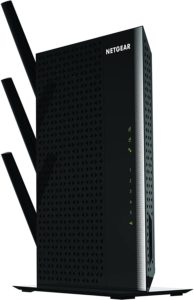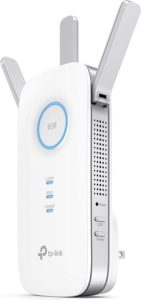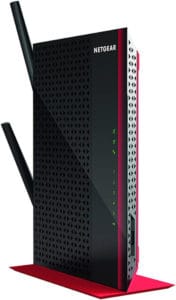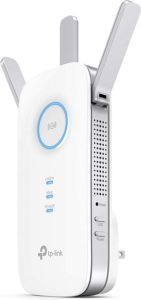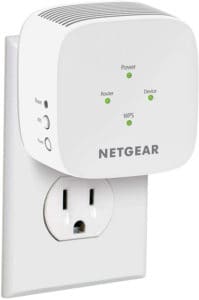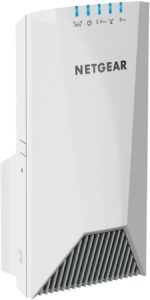Best Wi-Fi Extender For Gaming in 2023
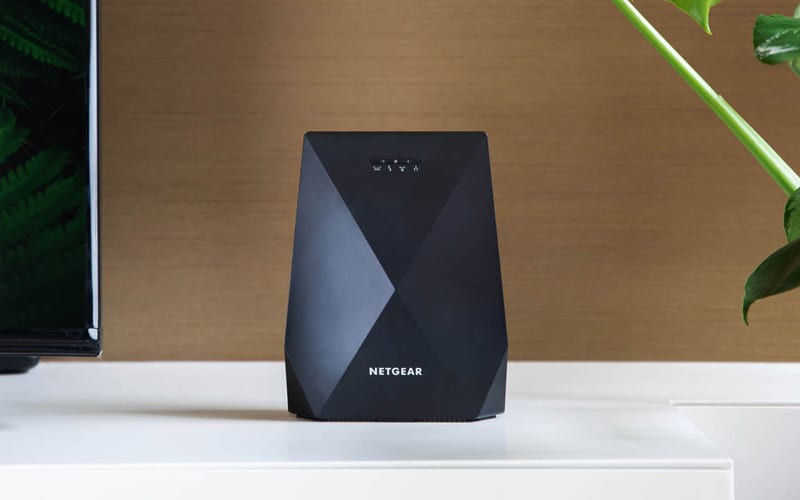
Table of Contents
While purists swear by wired internet for reliability and speeds, Wi-Fi technology has advanced to the point where gaming on a wireless network has moved beyond a convenient compromise to a veritable and capable option. And, in that sense, Wi-Fi extenders are a boon for home networks that suffer from a patchy or weak wireless signal, or worse, dead zones – Wi-Fi no man’s lands caused by dense walls or plain old distance to the wireless router.
For gamers, they can extend the Wi-Fi coverage of a home, negating the need to install a winding and often obtrusive wired Ethernet cable from the router to a gaming rig located in a bedroom or remote office. Speeds are more or less identical to wired Ethernet and stable enough for even the most competitive online games, especially when paired with one of the best signal-boosting extenders.
A saturated market means dozens of Wi-Fi extenders choose from, some great, some not so impressive. Sorting through them and deciphering the marketing blather to find one to suit a particular setup and range of needs can be a tedious and testing experience. To that end, we’ve scoured the market for the very best Wi-Fi extenders for gaming.
Products at a Glance
How we picked
When assessing Wi-Fi extenders, we relied on several core factors to choose the very best: Wi-Fi standard, speed, range, ease of setup and installation, antennas, in-built technologies such as MU-MIMO, and on-device Ethernet/USB ports.
Doing so allowed us to find five Wi-Fi extenders covering a range of budgets, form factors, and uses that, in our estimation, make the most of your money and provide a tangible improvement to gaming under the right conditions.
Read on to find a review of each that hones in on what impressed us and where each extender fell short, alongside brief pros and cons for a TL;DR assessment of each. Let’s dive in.
Product Reviews
- Speeds up to 2.2 Gbps
- Tri-band
- Easy to use Nighthawk app
- Retains SSID as existing network
- No Wi-Fi 6
The NETGEAR Wi-Fi Mesh Range Extender EX7500 is a robust, affordably priced plug-type extender with coverage up to 2,300 square feet and suitable for up to 45 different devices. It takes the top spot in our guide for the simple reason that it’s an easy-to-use option that doesn’t skimp on performance with throughput speeds up to 2.2 Gbps, more than enough for smooth, lag-free gaming.
The headline is NETGEAR’s patented FastLane 3 tech, which offers tri-band, one of which is dedicated solely to communicating with the router, which drastically limits slow down and won’t chew into precious bandwidth. Additionally, Smart Roaming ensures devices connect to the best available band for better speeds and stability. MU-MIMO allows the extender to communicate simultaneously with multiple devices, reducing signal wait times and overall network speeds.
Setting up a network and adding in extenders can quickly descend into an indecipherable mess of obscure technical terms and patience-testing troubleshooting. NETGEAR makes setting up the NETGEAR Wi-Fi Mesh Range Extender EX7500 a breeze thanks to the intuitive and well-designed Nighthawk app. Within minutes, you’ll have the new extender ready to go and can even test speeds, check on connected devices, and analyze your Wi-Fi signal for potential issues. In our experience, it’s one of the best proprietary apps out there.
Another nice touch for ease of use is that the NETGEAR Wi-Fi Mesh Range Extender EX7500 retains the same SSID name as your router, allowing devices that are already paired up with the network to connect seamlessly to the extender. Other manufacturers often force extenders to create a new SSID causing no end of connection issues as devices hop between the two.
- Router
- Beamforming and MU-MIMO tech
- Speeds up to 1.9 Gbps
- Smart Connect automatic optimal band selection
- No Wi-Fi 6
- More expensive than an extender
While investing in a Wi-Fi extender to complement an existing router is undoubtedly a viable route, another alternative is to update the router itself. The market is awash with hundreds of options, but for us, the beamforming and robust coverage of the TP-Link AC1900 Smart Wi-Fi Router (Archer A9) makes it a strong option for those dealing with troublesome dead zones.
The combination of beamforming technology that targets devices even at a considerable distance from the router to offer a more powerful signal, and multi-device MU-MIMO pushing out data to three devices simultaneously, ensures gaming is never interrupted by a sketchy connection. These technologies also contribute to the TP-Link AC1900 Smart Wi-Fi Router (Archer A9) boosting signal into those previously under-served corners of the home.
Theoretical speeds cap out at a more than respectable 1.9 Gbps, outclassing most speeds offered by ISPs. The Smart Connect feature is another excellent asset of the TP-Link AC1900 Smart Wi-Fi Router (Archer A9). It automatically switches a device away from congested bands for optimal performance, which reduces lag in gaming.
Naturally, opting for a router does up the cost of extending your Wi-Fi coverage compared to a plug-type Wi-Fi device. We believe the extra cost is worth it if you run an aging router in desperate need of an upgrade. The TP-Link AC1900 Smart Wi-Fi Router (Archer A9) doesn’t support Wi-Fi 6, dampening future-proofing credentials. Still, with so few devices equipped with the new standard, we’d wager this omission isn’t too debilitating.
- Speeds up to 1.2 Gbps
- 700mW amplifiers and 5dBi antennas
- FastLane and Beamforming+ technology
- Five Gigabit Ethernet ports
- Decently priced
- No Wi-Fi 6
- Larger profile than plug-type extenders
Standalone Wi-Fi extenders are a great middle-ground between an expensive full-blown router and a plug-type extender. The NETGEAR AC1200 Wireless Wi-Fi Range Extender (EX6200) is one such option and brings a lot to the table for gamers that require a reliable connection.
Signal boosting is well covered through in-built 700 mW amplifiers and two detachable five dBi dual-band exterior antennas. The NETGEAR AC1200 Wireless Wi-Fi Range Extender (EX6200) can reach theoretical speeds up to 1.2 Gbps, more than enough to satisfy even the most demanding multiplayer online games. Beamforming+ focuses the signal on devices, boosting coverage far beyond the router’s standard range.
With versatility in mind, the NETGEAR AC1200 Wireless Wi-Fi Range Extender (EX6200) sits either horizontally or in a space-saving vertical mode thanks to an included stand. The red and black color scheme looks sharp and wouldn’t be out of place next to a gaming rig located in a room that doesn’t benefit from full router coverage.
The extender also features five Gigabit Ethernet ports to hook up a Smart TV, console, or PC for an even more reliable connection. A USB 3.0 port allows you to hook up a storage device for network media sharing too.
A point worth noting is that the NETGEAR AC1200 Wireless Wi-Fi Range Extender (EX6200) is quite a lot larger than plug-type extenders, so you’ll need to factor in placement, which may not suit those that prefer a more conspicuous option.
- Speeds up 1.75 Gbps
- 2000 square foot coverage
- Affordable
- LED positioning indicator
- Easy installation
- Three external antennas
- Gigabit Ethernet port
- No Wi-Fi 6
- Hefty for a plug-type extender
The TP-Link AC1750 Wi-Fi Extender (RE450) delivers a much-needed signal boost for most setups with speeds up to 1.75 Gbps and a range of 2000 square feet, all at a very affordable price point. Three external antennas ensure a solid connection to all devices within range. With a Gigabit Ethernet port, there’s even the possibility to hardwire a gaming PC for that extra peace of mind when playing online.
A handy feature of the TP-Link AC1750 Wi-Fi Extender (RE450) is an intelligent blue/red signal light mounted on the front, which tells you whether the extender’s placement will deliver a strong connection to the router or not. Blue represents a good connection. Red means the extender is located too far from the router. This is a minor feature, but one that takes a lot of trial and error out of finding the right spot for an extender.
Alongside, the TP-Link AC1750 Wi-Fi Extender (RE450) includes easy two-button installation: press the RE button on the extender, then the WPS on the router, and the device is good to go. Once linked to the router, the extender can even be moved anywhere within the router’s range without re-configuring.
As plug-type extenders go, the TP-Link AC1750 Wi-Fi Extender (RE450) falls on the larger side, although that extra heft does generally deliver better performance than more diminutive extenders. Like numerous other extenders, it lacks Wi-Fi 6, but this shouldn’t be too much of an issue for most home setups.
- Speeds up to 1.2 Gbps
- Great budget price
- Compact form factor
- Smart LED placement indicators
- Easy setup
- No Wi-Fi 6
Although the above recommendations are laudable in their own right, there’s no need to spend a substantial amount on upgrading your wireless coverage in most situations. The NETGEAR WiFi Range Extender EX5000 is a budget WiFi 5 plug-type extender with all the features you’ll need to tackle those dead spots and ensure an uninterrupted wireless gaming experience.
The NETGEAR WiFi Range Extender EX5000 offers suitable speeds for gaming and HD streaming up to 1.2 Gbps. NETGEAR’s FastLane technology combines both 2.4 GHz and 5 GHz bands to establish a reliable, high-speed connection, while the high-power amplifiers and internal antennas ensure a strong signal.
Ease of installation and setup is baked into the NETGEAR WiFi Range Extender EX5000, one of the smallest extenders on the market, making it ideal for those who want to avoid a chunky device. Front-mounted smart LED indicators note whether the extender has power, is adequately connected to the router, and is transmitting data to devices. The router indicator is handy for hunting down that ideal position in the home. One press of the WPS button mounted on the side of the extender is all it takes to link up with your router.
The free WiFi Analytics app is also worth a mention, as it allows you to optimize the extender by relaying network status, WiFi signal strength by location, and channel interference to zero on the best setup for your home.
Things to consider
Wi-Fi Standard
The Wi-Fi standard supported by an extender is arguably the most important specification to consider. Opting for anything older than Wi-Fi 5 effectively cancels out the utility of a Wi-Fi extender as the device may improve the signal, but speeds simply aren’t suitable for modern gaming. Wi-Fi 5 is sufficient to deliver a lag-free experience with superb speeds and stability to boot.
Manufacturers are steadily releasing extenders with the latest standard, Wi-Fi 6, which offers a much more reliable signal, higher throughput speeds, and innovative device targeting technologies to improve stability. The relative infancy of the standard means few devices and routers support Wi-Fi 6, and spending more only makes sense if your whole network is Wi-Fi 6-ready. This also connects with our point about matching an extender to your router—more on that further down.
Types of Wi-Fi Extenders
Wi-Fi extenders come in two different form factors: plug-in socket type extenders and standalone units, similar in shape and size to a typical router. Both serve different situations, and choosing the right one depends on your personal circumstances and budget.
Plug-in extenders generally cost less and provide a convenient solution that can sit in any plug socket in your home, blending into a home’s decor. They are ideal for placing on the edge of the existing Wi-Fi signal range to give the network enough of a wireless boost to reach under-served corners of the home.
Standalone extenders feature a range of Ethernet and USB ports to connect devices such as consoles, printers, PCs, even media drives to share content across the network. They do cost more and have a larger footprint but tend to offer a more robust signal thanks to larger and more powerful antennas and better in-built technology.
Consider your needs before committing to a Wi-Fi extender. More modest setups should be fine with a plug type, while more elaborate networks with numerous devices benefit most from a standalone extender.
Router Specs
As a general rule of thumb, we recommend you mirror a Wi-Fi extender’s specifications to your router. Doing so will allow you to make the most of your router’s speeds and technologies and, by extension, ensure the best gaming experience possible. There’s no sense having an AX1500 router paired with an AC1200 extender as the extender won’t offer the same throughput speeds, nor will it make use of the extra Wi-Fi 6 band. The idea is to boost your existing network coverage rather than extend it with a paired down, comparatively worse connection.
Our Verdict
Our top recommendation for a Wi-Fi extender suitable for gaming is the NETGEAR Wi-Fi Mesh Range Extender EX7500. With speeds up to 2.2 Gbps, tri-band and plenty of helpful signal improving features, this is one of the easiest ways to ensure a wireless network reaches every nook and cranny of a home.
The TP-Link AC1900 Smart Wi-Fi Router (Archer A9) is a strong option if your current setup includes a tired router that needs replacing. While pricier than a traditional extender, this router features cutting-edge tech and blistering speeds of 1.9 Gbps that deliver a reliable gaming experience.
Those that want a little more broadcasting power from their extender should consider the NETGEAR AC1200 Wireless Wi-Fi Range Extender (EX6200). As a standalone device, it features good speeds, high-quality antennas, beamforming + technology, and plenty of Gigabit Ethernet ports to offer a more secure wired connection to a PC or a console.
The TP-Link AC1750 Wi-Fi Extender (RE450) stands as a great affordable option with expansive 2000 square foot coverage and speeds up to 1.75 Gbps. We’re big fans of the helpful LED positioning indicators and ease of installation – all the difference when you want to get up and running with little to no hassle.
Finally, you don’t need to spend much to land on a quality extender, and a prime example of this is the highly functional and reliable NETGEAR Wi-Fi Range Extender EX5000.
With that, we’ll bring our guide to the best Wi-Fi extenders for gaming to a close. Don’t hesitate to drop us a line below with any questions or comments.
NOW READ:


